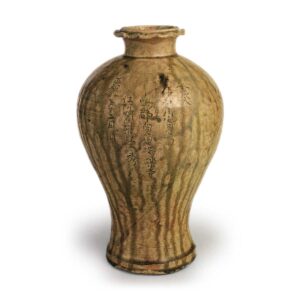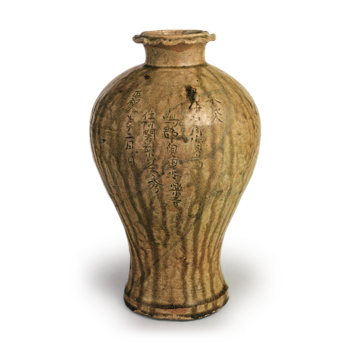
Excavated from the precincts of Nagataki Hakusan Shrine, Hakushima-cho, Gujo District, Gifu Prefecture
First year of the Showa Era (1312)
Height 30.4cm, Bore 7.3cm, Body 19.2cm, Bottom 12.0cm
Important Cultural Property
Hakusan Shrine
This vase was excavated from a part of the Hakusan Shrine grounds during the construction of the Echibi Minami Line in 1933, and is presumed to be from the Amyoin site. This jar was housed in a large jar from Tokoname, together with a piece of confectionery inscribed in the first year of the Shōwa Era and an ash-glazed four-mimi jar.
This child has the same type of body as the former one, but has a thicker oral portion and a petal-like rim band 1.0 cm wide and 0.3 cm thick on the lo rim. The other two pieces are similar and form a pair, but they are unique among Kosetoko, and as is known from the inscription, they are thought to have been made under special note.
The clay used for the base is of high quality with a high degree of refractoriness, and it shows extremely careful water-ground molding. The shoulders are less taut and the hips are slightly thicker. The firing was slightly oxidized, and a reddish-brown fire color appeared between the flames. The ash glaze is dark green in color and still has a strong flow of striations, but the shoulder portion is slightly thicker and shows a stable glaze tone. The inscription on the shoulder is engraved in a slightly thicker style with the inscription, “Dongshi-iru Hakusan Gongen bozen Hakusan Gongen bozen Nakajima-gun Okuda Anrakuji abbot Ajari Eishu Showa 1-nen 12 moons ago”. Okuda Village in Nakajima County is now Okuda, Inazawa City, in the central lowlands of the Owari Plain.
This bottle is extremely valuable as a reference material for old setko of the late Kamakura period.



